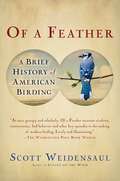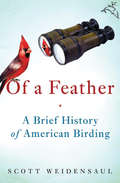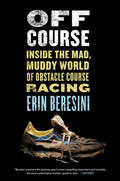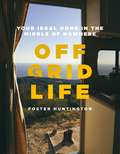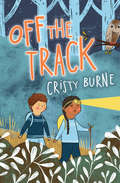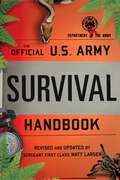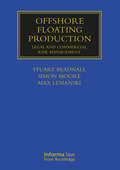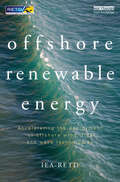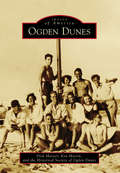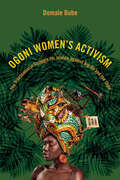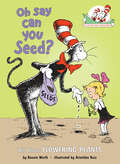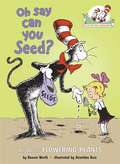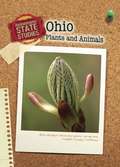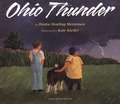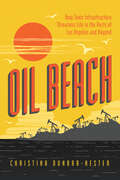- Table View
- List View
Of a Feather: A Brief History of American Birding
by Scott WeidensaulEuropeans were awestruck by a continent awash with birds. Today tens of millions of Americans birders have made a once eccentric hobby into something so mainstream its (almost) cool. Scott Weidensaul traces the colorful evolution of American birding.
Of a Feather: A Brief History of American Birding
by Scott WeidensaulBeyond Audubon: A quirky, &“lively and illuminating&” account of bird-watching&’s history, including &“rivalries, controversies, [and] bad behavior&” (The Washington Post Book World). From the moment Europeans arrived in North America, they were awestruck by a continent awash with birds—great flocks of wild pigeons, prairies teeming with grouse, woodlands alive with brilliantly colored songbirds. Of a Feather traces the colorful origins of American birding: the frontier ornithologists who collected eggs between border skirmishes; the society matrons who organized the first effective conservation movement; and the luminaries with checkered pasts, such as Alexander Wilson (a convicted blackmailer) and the endlessly self-mythologizing John James Audubon. Naturalist Scott Weidensaul also recounts the explosive growth of modern birding that began when an awkward schoolteacher named Roger Tory Peterson published A Field Guide to the Birds in 1934. Today, birding counts iPod-wearing teens and obsessive &“listers&” among its tens of millions of participants, making what was once an eccentric hobby into something so completely mainstream it&’s now (almost) cool. This compulsively readable popular history will surely find a roost on every birder&’s shelf. &“Weidensaul is a charming guide. . . . You don&’t have to be a birder to enjoy this look at one of today&’s fastest-growing (and increasingly competitive) hobbies.&” —The Arizona Republic
Off Course: Inside the Mad, Muddy World of Obstacle Course Racing
by Erin Beresini&“Beresini uncovers the growing sport&’s most compelling characters and provides the most authoritative insiders&’ guide to date.&” —Outside &“Obstacle course racing has taken the endurance world by storm, and in Off Course Erin Beresini gives us an insider perspective into the conflict and appeal of these masochistic suffer-fests, culminating in her quest to complete the granddaddy of them all, the Spartan Ultra Beast. A must-read for anyone currently competing in, or considering taking on, one of these newfangled racing events.&” —Dean Karnazes, best-selling author of Ultramarathon Man Everyone has seen the pictures on their social media feeds: friends or family wearing mud-spattered athletic gear, holding a medal to proclaim they&’ve crossed the finish line of an intensely grueling race. Indeed, obstacle course racing is the fastest growing sport in U.S. history. Every week, thousands of athletes shell out money to run through mud and fire, crawl under barbed wire, scramble over ten-foot walls, and dodge baton-wielding gladiators. Erin Beresini&’s Off Course chronicles the author&’s period of training and competition in obstacle course racing. As she investigates the world behind this military-inspired amateur competition and the industry surrounding it, Beresini meets the diverse characters who compete in these races and uncovers the sport&’s biggest scandals, lawsuits, and rivalries. And through her own race training, Erin illuminates the history, science, and psychology of this sport that is taking the endurance world by storm. &“[Beresini&’s] narrative has humor and heart, and a carnival of characters . . . By the end of her riotous narrative, I had to wipe mud from my glasses at least twenty-six times.&”—Gary M. Pomerantz, author of Their Life&’s Work: The Brotherhood of the 1970s Pittsburgh Steelers, Then and Now
Off Grid Life: Your Ideal Home in the Middle of Nowhere
by Foster HuntingtonBestselling Van Life author Foster Huntington shares his experiences - as well as others - living by his own rules in this aspirational book filled with awe-inspiring photographs of unique homes in unexpected places.After spending three years on the road living in a camper van, Foster Huntington continued his unconventional lifestyle by building a two-story treehouse. Foster, like many others, are finding freedom, tranquility, and adventure in living off the grid in unconventional homes.Perfect for fans of Van Life and Cabin Porn and those who yearn for a simpler existence, Off Grid Life showcases unique dwellings from all around the world. Organized into sections like tree houses, tiny houses, shipping containers, yurts, boathouses, barns, vans, and more, the 250 aspirational photographs feature enviable settings like stunning beaches, dramatic mountains and picturesque forests. Also included are images of fully designed interiors with kitchens and sleeping quarters as well as interviews with solo dwellers, couples, and families who are living lives off the beaten path.
Off the Grid
by Nick RosenInside the subculture of off-grid living Written by a leading authority on living off the grid, this is a fascinating and timely look at one of the fastest growing movements in America. In researching the stories that would become Off the Grid, Nick Rosen traveled from one end of the United States to the other, spending time with all kinds of individuals and families striving to live their lives the way they want to-free from dependence on municipal power and amenities, and free from the inherent dependence on the government and its far-reaching arms. While the people profiled may not have a lot in common in terms of their daily lives or their personal background, what they do share is an understanding of how unique their lives are, and how much effort and determination is required to maintain the lifestyle in the face of modern America's push toward connectivity and development. .
Off the Track
by Cristy BurneFrom the author of To the Lighthouse comes a new adventure for young readers about falling in love with the bush, and with hiking and being in the wild. It's about disconnecting from technology. And discovering yourself. Harry's perfect life was straying way off-track. He looked pleadingly at Mum. Surely she could see? Spending an entire weekend tramping around stinking-hot, snake-filled scrub was a horrible mistake. But doing it without a phone? That was just brutal. As it turns out, it was only the beginning ...
Off-Grid Solar Electrification in Africa: A Critical Perspective (Energy, Climate and the Environment)
by Nathanael OjongThis book evaluates off-grid solar electrification in Africa by examining how political, economic, institutional, and social forces shape the adoption of off-grid solar technologies, including how issues of energy injustice are manifested at different levels and spaces. The book takes a historical, contemporary, and projective outlook using case studies from pre- and ongoing electrification communities in non-Western countries such as Ghana, Kenya, Rwanda, Senegal, Malawi, Tanzania, and Nigeria. Beyond the diverse nature of these countries in terms of their geographical location in West, East, and Southern Africa, each offers a different experience in terms of colonial history, economic and institutional infrastructure, social and cultural context, and level of adoption of off-grid solar technologies. Notably, the book contributes to the off-grid solar and energy justice scholarship in low-income non-Western contexts. It examines various approaches to energy justice and does so by engaging with Western and non-Western philosophical notions of the concept. It takes into consideration the major principles of Ubuntu philosophy with the adoption of off-grid solar technologies, hence enriching the energy justice framework. Finally, the book interrogates the degree to which the social mission that catalysed the expansion of the off-grid solar sector is being undermined by broader structural dynamics of the capital investment upon which it is reliant. It also argues that the ascendance of off-grid solar electrification in Africa is transformative in that it enables millions of people without access to or facing uncertainties linked to centralised grid energy to have access to basic energy services.
Official Guide to Texas State Parks and Historic Sites
by Laurence ParentSince it was first published in 1996, Official Guide to Texas State Parks and Historic Sites has become Texans' one-stop source for information on great places to view scenic landscapes, tour historical sites, camp, fish, hike, backpack, swim, ride horseback, go rock climbing, and enjoy almost any other outdoor recreation. This revised edition includes five new state parks and historical sites, completely updated information for every park, and many beautiful new photographs. The book is organized by geographical regions to help you plan your trips around the state. For every park, Laurence Parent provides all of the essential information:- The natural or historical attractions of the park- Types of recreation offered- Camping and lodging facilities- Addresses and phone numbers- A locator map- Magnificent color photographs So if you want to watch the sun set over Enchanted Rock, fish in the surf on the beach at Galveston, or listen for a ghostly bugle among the ruins of Fort Lancaster, let this book be your complete guide. Don't take a trip in Texas without it.
Official U.S. Army Map Reading and Land Navigation Handbook
by Department of the ArmyThe U.S. Army&’s official guide to map reading, determining location, and navigatingFor a soldier, knowing where you are is a matter of life and death, and so it comes as no surprise that the Army has produced the most complete, clear, and thorough guide to map reading and navigation available.The book starts with a comprehensive explanation of the meaning and uses of maps, whether photographic, planimetric (standard-style), or topographic, then proceeds to the use of those maps, discussing compass techniques, celestial navigation, and determination of distance. There is a detailed section on interpreting topographic maps, with notes on tactical considerations for differing terrain, as well as determining the ease of movement through an area. The book&’s crucial, well-illustrated chapters have invaluable information on:Training StrategyMapsMarginal Information and SymbolsGridsScale and Distance Direction OverlaysAerial PhotographsNavigation Equipment and MethodsElevation ReliefTerrain AssociationMounted Land NavigationNavigation in Different Types of TerrainUnit SustainmentThere is also information on field sketching, the tricky art of map folding, units of measure and conversion factors, map symbols, orienteering, and the global positioning system (GPS).
Official U.S. Army Survival Handbook (U.S. Army)
by Department of the Army Matt LarsenWhether in a temperate, tropical, arctic, or subarctic region, you might find yourself alone in a remote area with little or no personal gear. This thoroughly revised new edition of the classic U.S. Army Survival Handbook provides the information you need to survive. Widely recognized as the finest single source on the subject, it is standard issue for U.S. Special Operations Forces and pilots, and has been used by foreign militaries the world over. An essential resource for all outdoorspeople—including campers, hunters, hikers, and anglers—the U.S. Army Survival Handbook is a comprehensive volume replete with hundreds of full-color, easy-to-follow, user-friendly illustrations.
Offshore Energy and Marine Spatial Planning (Earthscan Oceans)
by Corey J. Bradshaw Katherine L. YatesThe generation of offshore energy is a rapidly growing sector, competing for space in an already busy seascape. This book brings together the ecological, economic, and social implications of the spatial conflict this growth entails. Covering all energy-generation types (wind, wave, tidal, oil, and gas), it explores the direct and indirect impacts the growth of offshore energy generation has on both the marine environment and the existing uses of marine space. Chapters explore main issues associated with offshore energy, such as the displacement of existing activities and the negative impacts it can have on marine species and ecosystems. Chapters also discuss how the growth of offshore energy generation presents new opportunities for collaboration and co-location with other sectors, for example, the co-location of wild-capture fisheries and wind farms. The book integrates these issues and opportunities, and demonstrates the importance of holistic marine spatial planning for optimising the location of offshore energy-generation sites. It highlights the importance of stakeholder engagement in these planning processes and the role of integrated governance, with illustrative case studies from the United States, United Kingdom, northern Europe, and the Mediterranean. It also discusses trade-off analysis and decision theory and provides a range of tools and best practices to inform future planning processes.
Offshore Fishes of California
by John E. FitchThe California angler who pursues his chosen sport in the waters of the blue Pacific is, without a doubt, one of the luckiest fishermen in the world. The more than 1,000 miles of ocean shoreline that extend from San Diego to Crescent City (Mexico to Oregon) offer in combination a greater variety of fish and fish habitat, a more extensive fishing area, a better choice of excellent boat launching sites, and a wider selection of highly skilled sport-fishing boat operators than are to be found along any similar stretch of coast anywhere in the world.
Offshore Floating Production: Legal and Commercial Risk Management (Maritime and Transport Law Library)
by Simon Moore Stuart Beadnall Max LemanskiThis is the first book to focus on the law and practice relating to offshore oil and gas floating production. It deals with all legal and commercial risk management issues from initial concept through design, construction, modification, installation, acceptance, production and offloading, including ancillary legal topics; JV/consortiums, financing, insurance, decommissioning and intellectual property. Floating production projects are a popular method of achieving offshore oil and gas production, utilising vessels sitting over the offshore reservoir, receiving well fluids which are then processed, stored and offloaded to tankers. They operate in deep water, harsh conditions and marginal fields, and may be redeployed once the reservoir is depleted. There are numerous legal issues which arise in the context of floating production due to its specific characteristics, presenting a unique combination of challenges with the attendant risks and potential liabilities. This book analyses these risks and liabilities and considers how they may be allocated between the parties, how the consequences are avoided or mitigated and how disputes are in practice resolved. It illustrates these issues and competing legal arguments by focusing on each stage of the relationship between the oil and gas company and a specialist floating production contractor. The book will be of special interest to project managers and in-house lawyers at oil companies, offshore contractors, design consultants, construction companies, suppliers, vessel operators, banks, insurers and investors. It will also be of particular use to private practice lawyers in all jurisdictions where these projects occur; because contracts used in this industry are often written under English law,and contracts which are governed by local law follow a similar pattern.
Offshore Renewable Energy: Accelerating the Deployment of Offshore Wind, Tidal, and Wave Technologies
by Iea-Retd (Stichting Foundation RenewableWave, tidal and offshore wind technologies have long held the promise of seemingly limitless energy supplies. In practice, while offshore wind is growing relatively rapidly, all three sectors have lagged behind expectations. This book, from the International Energy Authority Renewable Energy Technology Deployment implementing agreement (IEA-RETD), examines the reasons for this and suggests how barriers to deployment might be overcome. Beginning with an assessment of the marine energy resource, it provides a detailed introduction to the main technologies currently being employed to harness wind, tidal and offshore wind power. It then examines the types of policies which are used to encourage deployment around the world, and progress towards meeting targets. The economics of offshore energy projects are discussed, along with risks that projects face and the types of finance which are available. A final section turns to barriers - both technical and non-technical (including environmental, health and safety, skill related, supply chain and more) - and in all cases suggests how to mitigate and remove these barriers. Highly illustrated in full colour, this is an indispensable resource for anyone - whether in industry, policy or academia - looking to learn more about how deployment of offshore renewable energy technologies can be encouraged.
Offshore Sea Life ID Guide: East Coast (Princeton Field Guides)
by Steve N. Howell Brian L. SullivanThe first compact field guide to offshore sea life of the East CoastTwo-thirds of our planet lies out of sight of land, just offshore beyond the horizon. What wildlife might you see out there? This handy guide, designed for quick use on day trips off the East Coast, helps you put a name to what you find, from whales and dolphins to shearwaters, turtles, and even flying fish. Carefully crafted color plates show species as they typically appear at sea, and expert text highlights identification features. Essential for anyone heading out on a whale-watching or birding trip, this guidebook provides a handy gateway to the wonders of the ocean.Over 100 color photos and composite platesIncludes whales, dolphins, birds, sharks, turtles, flying fish, and moreAccessible and informative text reveals what to look forGreat for beginners and experts alike
Ogallala, Third Edition: Water for a Dry Land (Our Sustainable Future)
by Char Miller John Opie Kenna Lang ArcherThe Ogallala aquifer, a vast underground water reserve extending from South Dakota through Texas, is the product of eons of accumulated glacial melts, ancient Rocky Mountain snowmelts, and rainfall, all percolating slowly through gravel beds hundreds of feet thick.Ogallala: Water for a Dry Land is an environmental history and historical geography that tells the story of human defiance and human commitment within the Ogallala region. It describes the Great Plains’ natural resources, the history of settlement and dryland farming, and the remarkable irrigation technologies that have industrialized farming in the region. This newly updated third edition discusses three main issues: long-term drought and its implications, the efforts of several key groundwater management districts to regulate the aquifer, and T. Boone Pickens’s failed effort to capture water from the aquifer to supply major Texas urban areas. This edition also describes the fierce independence of Texas ranchers and farmers who reject any governmental or bureaucratic intervention in their use of water, and it updates information about the impact of climate change on the aquifer and agriculture.
Ogden Dunes
by Dick Meister Historical Society of Ogden Dunes Ken MartinOgden Dunes, incorporated in 1925, is the largest and most residential of the three Porter County lake-front communities established in the 1920s. Although it began as a highly restricted resort community with the largest man-made ski jump in North America, it became a middle-class residential community after 1945. Because of its proximity to Gary and Chicago, Ogden Dunes was also a battleground between the forces that wished to conserve the dunes and those that pushed for industrializing them. Alice Gray, Diana of the Dunes; Dorothy Buell, who led the fight to create a national park; and Dale Messick, the creator of comic strip Brenda Starr: Girl Reporter were important members of the community. Over the years, Ogden Dunes has provided a creative and supportive environment for children and adults, especially those with artistic talents and interests.
Oglebay Park
by Brent CarneyIn 1926, Earl Oglebay willed his summer estate, Waddington Farm, to the city of Wheeling with the hope that it would provide entertainment and education to the community. He and naturalist A.B. Brooks, both mavericks in ecology and agricultural training, established the unique environmental emphasis still evident in the park's nature center, trails, Discovery Lab, and zoo. The 1,650-acre municipal park nestled in the Wheeling hills also features Wilson Lodge, the premier hotel in the area, and 49 log cabins that pay tribute to the community's storied frontier past. The cabins and the Pine Room Pool were built in the 1930s by the Civilian Conservation Corps. Those brave young men, along with a famous golf course architect, Bob Biery, created the Oglebay Caddy Camp, which has been featured in several major golf magazines. Today, Oglebay Park hosts festivals, legendary jazz bands, and top-notch equestrian events. The park's Winter Festival of Lights is considered to be the nation's largest light show.
Ogoni Women's Activism: The Transnational Struggle for Justice against Big Oil and the State (NWSA / UIP First Book Prize)
by Domale DubeIn 1995, Nigeria’s dictatorial government executed nine Ogoni leaders fighting for civil rights and against Shell Oil’s depredations of Ogoni land. Domale Dube draws on interviews and participant observation to tell the long-ignored story of how women carved out a role in the Ogoni pursuit of justice. Dube’s account examines and documents the issues that drew women into the movement, from concerns for themselves and their communities to grander visions for the Ogoni. As she shows, these issues not only influenced organizing in Nigeria but also the diaspora in general and the United States in particular. Ogoni women relied upon nonviolent protest to realize their aims. Dube looks at their campaigns and how their actions reflected their concerns, values, interests, and priorities. The result is a rare account of Black women and transnational organizing for women’s, climate, and environmental justice that merges a history of their involvement with an in-depth analysis of the racial, gender, and ethnic dimensions of the Ogoni Struggle.
Oh Say Can You Seed? All About Flowering Plants: All About Flowering Plants (The Cat in the Hat's Learning Library)
by Bonnie WorthLaugh and learn with fun facts about flowers, plants, fruit, and more—all told in Dr. Seuss&’s beloved rhyming style and starring the Cat in the Hat! &“I&’m the Cat in the Hat, and I think that you need to come take a look at this thing called a seed.&” The Cat in the Hat&’s Learning Library series combines beloved characters, engaging rhymes, and Seussian illustrations to introduce children to non-fiction topics from the real world! Grow your brain with fun facts about flowering plants and learn: how they all start out as a seedhow they make their own food inside their leaveshow bees help spread the pollen flowers need to produce fruitand much more!Perfect for story time and for the youngest readers, Oh Say Can You Seed? All About Flowering Plants also includes an index, glossary, and suggestions for further learning. Look for more books in the Cat in the Hat&’s Learning Library series!High? Low? Where Did It Go? All About Animal CamouflageIs a Camel a Mammal? All About MammalsThe 100 Hats of the Cat in the Hat: A Celebration of the 100th Day of SchoolA Great Day for Pup: All About Wild BabiesWould You Rather Be a Pollywog? All About Pond LifeHappy Pi Day to You! All About Measuring CirclesI Can Name 50 Trees Today! All About TreesFine Feathered Friends: All About BirdsMy, Oh My--A Butterfly! All About ButterfliesInside Your Outside! All About the Human BodyIce is Nice! All About the North and South Poles
Oh Say Can You Seed?: All About Flowering Plants
by Bonnie WorthWith the able assistance of Thing 1 and Thing 2 -- and a fleet of Rube Goldbergian vehicles -- the Cat in the Hat examines the various parts of plants, seeds, and flowers; basic photosynthesis and pollination; and seed dispersal.
Oh, the Lavas That Flow! All About Volcanoes (The Cat in the Hat's Learning Library)
by Todd TarpleyLaugh and learn with fun facts about hot lava, ash clouds, volcanos, and more—all told in Dr. Seuss&’s beloved rhyming style and starring the Cat in the Hat!&“I&’m the Cat in the Hat, and I&’m here to explain-o some marvelous facts all about the volcano!&” The Cat in the Hat&’s Learning Library series combines beloved characters, engaging rhymes, and Seussian illustrations to introduce children to non-fiction topics from the real world! Erupt with laughter while you discover:• how most volcanoes are underwater• what the difference between lava and magma is• how volcanoes help create rain and new land• and much more!Perfect for story time and for the youngest readers, Oh, the Lavas That Flow! All About Volcanoes also includes an index, glossary, and suggestions for further learning. Look for more books in the Cat in the Hat&’s Learning Library series!If I Ran the Horse Show: All About HorsesClam-I-Am! All About the BeachMiles and Miles of Reptiles: All About ReptilesA Whale of a Tale! All About Porpoises, Dolphins, and WhalesSafari, So Good! All About African WildlifeThere's a Map on My Lap! All About MapsOut of Sight Till Tonight! All About Nocturnal AnimalsWhat Cat Is That? All About CatsOnce upon a Mastodon: All About Prehistoric MammalsOh Say Can You Say What's the Weather Today? All About WeatherThe Cat on the Mat: All About Mindfulness
Ohio Plants and Animals (Heinemann State Studies)
by Marcia SchonbergWhere is Ohio can you find 300-year-old oak trees? Which pesticide has endangered the bald eagle in Ohio? What kinds of animals live in Ohio's cities? This books contains all kinds of fun and fascinating facts about the plants and animals of Ohio and the habitats in which they live. You'll find information about where and how Ohio plants and animals live, and how these living things fit into the ecosystem. Plus, you'll find out what actions are being taken to protect Ohio's natural environment.
Ohio Thunder
by Denise Dowling Mortensen Kate KieslerZAP! One hundred million volts. Cloud to ground advancing bolts. Lyrical verse and stunning illustrations vividly bring to life the speed and drama of a summer storm on a midwestern farm. Gorgeous paintings depict blackened skies above vast stretches of farmland, long tracts of tall corn, and brightly colored barns, but also add subtext to the story, showing two farm boys and their father reacting to the sudden shift in the weather. This remarkable pairing of word and pictures conveys a sense of wonder about the natural world and makes for a picture book any child who has ever been frightened by a storm will respond to.
Oil Beach: How Toxic Infrastructure Threatens Life in the Ports of Los Angeles and Beyond
by Christina Dunbar-HesterCan the stories of bananas, whales, sea birds, and otters teach us to reconsider the seaport as a place of ecological violence, tied to oil, capital, and trade? San Pedro Bay, which contains the contiguous Ports of Los Angeles and Long Beach, is a significant site for petroleum shipping and refining as well as one of the largest container shipping ports in the world—some forty percent of containerized imports to the United States pass through this so-called America’s Port. It is also ecologically rich. Built atop a land- and waterscape of vital importance to wildlife, the heavily industrialized Los Angeles Harbor contains estuarial wetlands, the LA River mouth, and a marine ecology where colder and warmer Pacific Ocean waters meet. In this compelling interdisciplinary investigation, award-winning author Christina Dunbar-Hester explores the complex relationships among commerce, empire, environment, and the nonhuman life forms of San Pedro Bay over the last fifty years—a period coinciding with the era of modern environmental regulation in the United States. The LA port complex is not simply a local site, Dunbar-Hester argues, but a node in a network that enables the continued expansion of capitalism, propelling trade as it drives the extraction of natural resources, labor violations, pollution, and other harms. Focusing specifically on cetaceans, bananas, sea birds, and otters whose lives are intertwined with the vitality of the port complex itself, Oil Beach reveals how logistics infrastructure threatens ecologies as it circulates goods and capital—and helps us to consider a future where the accumulation of life and the accumulation of capital are not in violent tension.
